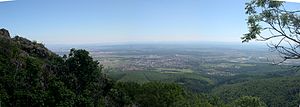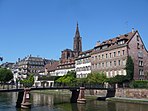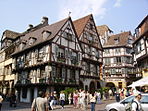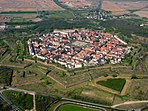Elsass
| Alsace | ||||||||||
|---|---|---|---|---|---|---|---|---|---|---|
Cernay and the plain of Alsace; Strasbourg; Colmar; Castle of Haut-Koenigsbourg; Riquewihr; Northern Vosges Regional Nature Park; Mulhouse; Neuf-Brisach
|
||||||||||
|
||||||||||
 |
||||||||||
| Country | France | |||||||||
| Administrative region | Grand Est | |||||||||
| Prefecture | Strasbourg | |||||||||
| Departments | ||||||||||
| Area | ||||||||||
| • Total | 8,280 km2 (3,200 sq mi) | |||||||||
| Population (2014) | ||||||||||
| • Total | 1,872,949 | |||||||||
| Demonym(s) | Alsatian | |||||||||
| ISO 3166 code | FR-A | |||||||||
Alsace (/ælˈsæsˌælˈseɪsˌˈælsæsˌˈælseɪs/,French: [al.zas]; Alsatian: ’s Elsass [ˈɛlsɑs]; German: Elsass[ˈɛlzas]; Latin: Alsatia) is a cultural and historical region in eastern France now located in the administrative region of Grand Est. Alsace is located on France's eastern border and on the west bank of the upper Rhine adjacent to Germany and Switzerland.
From 1982 until January 2016, Alsace was also the smallest (but not the least populated) of 22 administrative régions in metropolitan France, consisting of the Bas-Rhin and Haut-Rhin departments. Territorial reform passed by the French legislature in 2014 resulted in the merger of the Alsace administrative region with Champagne-Ardenne and Lorraine to form Grand Est.
...
Wikipedia










